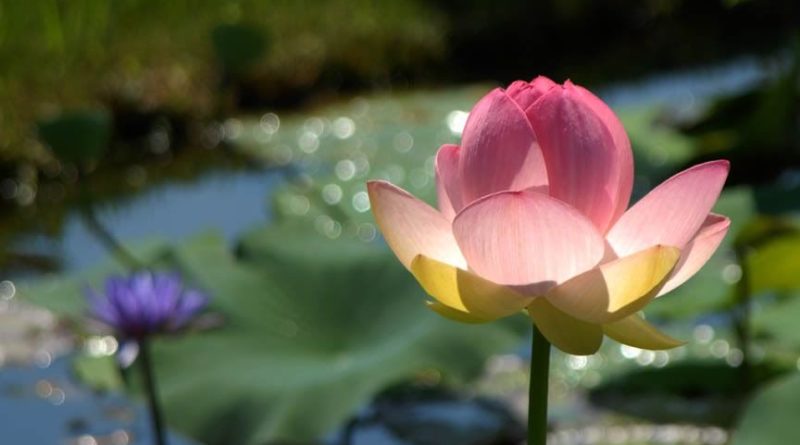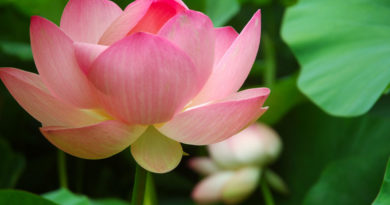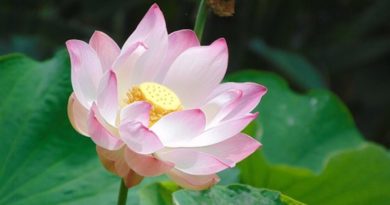ALL OF US – BESET BY BIRTH, DECAY AND DEATH – CHAPTER 10: OUR UNDERLYING TENDENCIES
Most people are inclined to blame either themselves or others for whatever they consider wrong. Some people like to blame mostly others, some prefer to blame themselves. Neither way is profitable, or will bring peace of mind. It may help to really get a grip on the facts that prevail within each human being by knowing the underlying tendencies (//anusaya//) within us.
If we understand that every human being has these tendencies, then we may be less inclined to blame or be upset or take offence and more inclined to accept with equanimity. We may be more prone to work on these negatives when we become aware of them in ourselves.
The underlying tendencies are more subtle than the five hindrances (//panca nivarana//): the hindrances are gross and exhibit themselves in that way. Sensual desire: wanting that which is pleasing to the senses. Ill-will: getting angry, upset. Sloth and torpor: having no energy whatsoever. Sloth refers to the body, torpor to the mind. Restlessness and worry: being ill-at-ease, no peacefulness. Sceptical doubt: not knowing which way to turn. These five are easily discernible in oneself and others. But the underlying tendencies are more difficult to pinpoint. They are the hidden sources for the hindrances to arise, and in order to get rid of them, one needs keen mindfulness and a great deal of discernment.
Having worked with the five hindrances in oneself and to a certain degree having let go of their grossest aspects, one can begin work on the underlying tendencies. The word itself suggests their characteristic, namely, that their roots are deeply imbedded and therefore hard to see and eliminate.
The first two tendencies are similar to the hindrances sensuality and irritation, being the underlying bases for sensual desire and anger. Even when sensual desire has been largely abandoned and anger no longer arises, the disposition to sensuality and irritation remain.
Sensuality is part and parcel of a human being and shows itself in becoming attached and reacting to what one sees, hears, smells, tastes, touches and thinks. One is concerned with what one feels and has not yet come to the understanding that the sense objects are only impermanent phenomena arising and passing away. When this lack of profound insight is still prevalent, one ascribes importance to the impressions which come in through the senses. One is drawn to them and seeks pleasure in them. When the senses are still playing an important part in a person, there is sensuality. Man is a sensuous being. There is a verse which describes the noble Sangha as having “pacified senses.” The Loving-Kindness Sutta (//Karaniyametta Sutta//) describes the ideal monk as “with senses calmed.” In many a sutta the Buddha said that getting rid of sense desire is the way to //Nibbana//.
Sensuality as an ingrained part of being human has to be transcended with great effort and cannot be done without insight. It’s impossible to succeed just by avowing: “sensuality isn’t useful, I’ll let go of it.” One has to gain the insight that these sense contacts have no intrinsic value in themselves. There is a coming together of the sense base (eye, ear, nose, tongue, skin, mind) with the sense object (sight, sound, smell, taste, touch, thought) and the sense consciousness (seeing, hearing, smelling, tasting, touching, thinking) to form an impingement. That’s all that’s happening. As long as one reacts to these contacts as if they had importance, there is sensuality. Where there is sensuality, there is also irritation, the two go hand in hand. Sensuality is satisfied when the sense contact impingement was pleasant. Irritation arises when the sense contact was unpleasant. It doesn’t have to issue as anger, shouting, fury, hate or even resistance. It’s just irritation, which results in being displeased, feeling ill-at-ease and restless. It goes together with being a sensuous human being.
Sensuality and irritation only disappear for the Non-returner (//Anagami//). The last stage before full Enlightenment: one who does not return to this realm, but attains //Nibbana// in the “Pure Abodes”. Even the Stream-enterer (//Sotapanna//) and the Once- returner (//Sakadagami//), the first and second stage of noble attainment, are still beset by the //dukkha// of sensuality and irritation.
If one imagines that the impulse creating sensuality or irritation is outside of oneself, one hasn’t seen the beginning of the path yet. It is necessary to realize that the reaction is our own, so that we may start work on ourselves. If we don’t even notice it happening, how can we do anything about it? It’s occurring constantly, without let-up, so that we have innumerable occasions to become aware of our inner world.
Becoming aware doesn’t mean yet that we can get rid of our reactions. There also has to be an understanding of the futility of an unwholesome response and an effort to investigate the causes. It’s easy to see that sensuality and irritation are the underlying tendencies which creates sensual desire and ill-will. This insight should arouse a little acceptance and tolerance towards one’s own difficulties and those of other people. If this is happening to everyone constantly, then what is there to get upset about? The only thing to do is to work with it, to use it as one’s subject for contemplation (//kammatthana//) and introspection. It’s well worthwhile to use one’s difficulties as one’s method for the task of purification.
Our tendencies and hindrances are all interconnected. If one is able to diminish one, the others also become a little less obstructive, lose their heaviness and cease to be so frightening. People generally fear their own reactions. That is why they often feel threatened by others; they’re not so much afraid of the other person’s reaction, but far more so of their own. They’re unsure of themselves, fearing to become aggressive, angry and then losing some of their own self-image.
Having a self-image is very detrimental, because it is based on the illusion of permanence. Everything constantly changes, including ourselves, while a self-image presupposes stability. One moment we may be a sensual being, the next moment an irritable one. Sometimes we are at ease, at other times we are restless. Which one are we? To have an image of oneself creates a concept of permanence which can never have any basis in fact. It blocks one’s insight into the underlying tendencies because one will be blind to those which do not fit one’s image.
The third underlying tendency is doubt or hesitation. If one has doubts, one hesitates: “What am I going to do next?” One doubts one’s own path and abilities, and how to proceed. Due to hesitation, one doesn’t use one’s time wisely. At times one may waste it or overindulge in activities which are not beneficial. Doubt means that one doesn’t have an inner vision to guide one, but is obsessed by uncertainty. Doubts and hesitation lie in our hearts because of a feeling of insecurity. We are afraid of not being safe. But there’s no safety anywhere, the only one that can be found is //Nibbana//. This fear and insecurity in the heart cause doubt and hesitation to arise. If we were to leave them behind and not pay any attention to them, we could step ahead so much more easily and could accomplish many times more.
Doubt and hesitation are abandoned with Stream-entry. The one who has attained the first Path and Fruit no longer doubts, because that person has had a personal experience of an unconditioned reality, totally different from the relative reality in which we live. He can now forge ahead without worry or fear. There can be no doubt about a direct experience. If we tell a small child: “Please don’t touch the stove, you might get burned,” it’s quite likely that the child will nevertheless touch the stove. Having once touched it and experienced the painful feeling of being burned, he will surely never touch it again. The experience removes doubt and hesitation.
The next underlying tendency is the wrong view (//ditthi//) of relating all that happens to a “self.” This goes on constantly and we can verify that easily, as it happens to everybody. Very few people realize: “This is just mental phenomena.” They believe: “I think.” When there is pain in the body, few will say: “It’s just an unpleasant feeling.” They’ll say: “I’m feeling very badly,” or “I have a terrible pain.” This reaction to whatever happens as “self” is due to an underlying tendency so deeply imbedded that it takes great effort to loosen its hold.
To lose the wrong view of self does not simply mean to intellectually understand that there is no real “self.” What is required is an inner view of this whole conglomeration of mind and body as nothing but mere phenomena without ownership. The first step is taken at Stream-entry, when right view of “self” arises, though all clinging to self-concepts is abandoned only at //Arahant// level.
Next comes pride and conceit (//mana//), which here means having a certain concept of ourselves, such as being a man or a woman, young or old, beautiful or ugly. We conceive of what we want, feel, think, know, own and what we can do. All this conceptualizing creates ownership and we become proud of possessions, knowledge, skills, feelings, being someone special. This pride may be deeply hidden in ourselves and hard to find and may need some introspective digging. This is due to the fact that so much of our whole being is involved. When we say: “Now find that concept about being a woman,” the answer often is: “Of course, I am a woman, what else am I?” But as long as “I am” anything, woman, man, child, stupid or intelligent, “I am” far from //Nibbana//. Whatever I conceptualize myself to be stops me in my tracks.
The underlying tendency of pride and conceit is only uprooted for the //Arahant//. There’s no directly discernable relationship to any of the hindrances there, but the conceiving of “self” and the wrong view of “self” are the chief manifestations of delusion, the root cause for all our defilements.
Next we come to clinging to existence (//bhavaraga//). That’s our survival syndrome, clinging to being here, not willing to give up, not ready to die today. We must learn to be ready to die now, not wishing to die, but to be ready for it. Wishing to die is the other side of the same coin of clinging to existence. It’s trying to get rid of existence because life is too difficult. But being ready to die now means that the clinging to being someone and being here to prove it, has been abandoned, for it has been seen to be a fallacy. At that time wrong view of “self” has been eliminated.
Clinging to existence brings us into a dependency syndrome. We want everything to work out well for us and resent it if that doesn’t happen. This creates irritation and sensuality. We often forget that we are only guests here on this planet and our visit is limited and can be over at any time. This clinging to being alive brings much difficulty to all of us because it projects us into the future so that we can’t attend to the present. If we don’t live in the present, we’re missing out on being alive at all. There’s no life in the future, it’s all ideation, conjecture, a hope and a prayer. If we really want to be alive and experience things as they are, we’ve got to be here now, attending to each moment. This entails letting go of clinging to what will happen to us in the future, particularly whether we are going to continue to exist. Existing in this moment is enough. To be able to let go of that clinging means to let go of the future, only then will there be strong mindfulness, real attention and clear knowing.
Clinging to existence will always give us the idea that something better will come along if we just wait long enough and that denies effort. Effort can only be made now, who knows what tomorrow will bring?
The last of the seven tendencies is ignorance (//avijja//). Ignoring the Four Noble Truths. Ignorance is the so-called starting point in the chain of cause and effect which brings us back to birth and death again and again. Ignorance opposes wisdom, and here it concerns the fact that we disregard reality by not realizing that all our //dukkha// comes from wanting, even if our desire may be a wholesome one. If we continue to ignore the first two noble truths, not to speak of the third truth, which is //Nibbana//, we are enmeshed in //dukkha//. Our underlying tendency of ignorance eventuates in the wrong view of “self” — the conceiving of a “self” — showing us the interconnection of all the underlying tendencies. Without ignorance there wouldn’t be any sensuality and irritation, nor any hesitation or doubt, no wrong view, nor pride and conceit, or clinging to existence.
It’s very useful to pick the characteristic that creates difficulties for us over and over again and make it one’s focus of attention. Since they are all interconnected, minimizing one will help to reduce the others to more manageable proportions.
To see these underlying tendencies in oneself takes a great deal of proper attention towards oneself, which needs time and solitude. One can’t do it while talking with others. If the mind is clear one can do it during meditation sessions or through contemplation.
Contemplation is a valid adjunct to meditation, an important helpmate and is always directed towards insight, while meditation may at times be geared towards serenity. Contemplation means looking inward and trying to see what arises: “What makes me tick?” With utter truthfulness, remembering the underlying tendencies, knowing that everybody has them, one can ask: “How are they manifesting in me?” Once that has been seen, there is further validity in contemplating: “What can I do about getting rid of this particular tendency, or at least minimizing it?” One should allot some time during each day for contemplation. If one has spent a whole day without introspection, one can’t hope to go inward at meditation time.
Meditation and contemplation complement and need each other.







